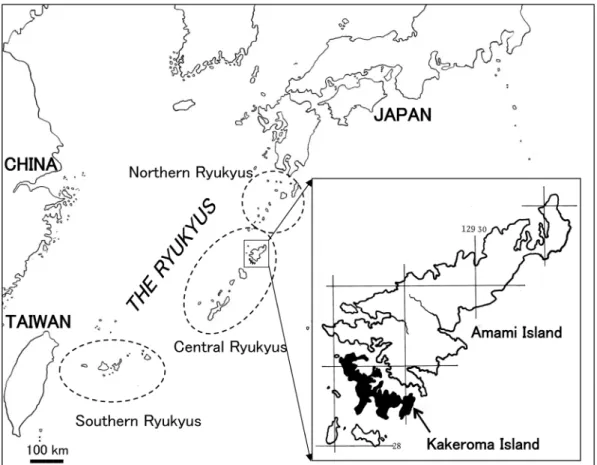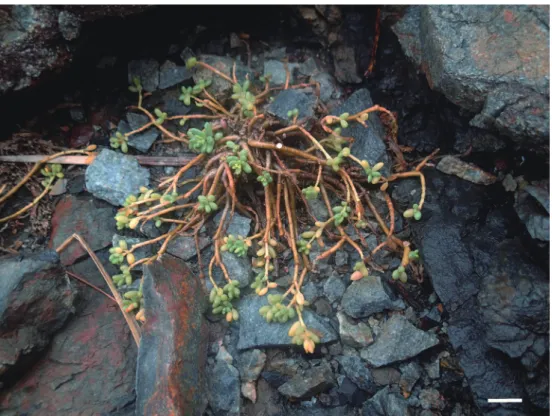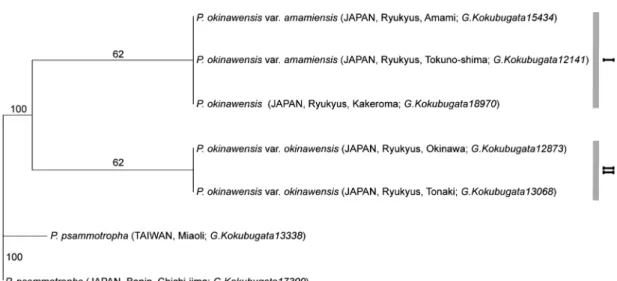Bull. Natl. Mus. Nat. Sci., Ser. B, 42(2), pp. 67–71, May 23, 2016
Confirmation of the Occurrence of Portulaca okinawensis var. amamiensis (Portulacaceae) in Kakeroma Island of the Ryukyus Archipelago,
Japan using Morphological and Molecular Data
Goro Kokubugata1,2,*, Takuro Ito2 and Masatsugu Yokota3
1 Department of Botany, National Museum of Nature and Science, Amakubo 4–1–1, Tsukuba, Ibaraki 305–0005, Japan
2 United Graduate School of Agricultural Science, Tokyo University of Agriculture and Technology, Saiwai-cho 3–5–8, Fuchu, Tokyo 183–8509, Japan
3 Laboratory of Ecology and Systematics, Faculty of Science, University of the Ryukyus, Nishihara, Okinawa 903–0213, Japan
* E-mail: gkokubu@kahaku.go.jp (Received 12 February 2016; accepted 23 March 2016)
Abstract Plants of Portulaca okinawensis from Kakeroma Island, an islet adjacent to Amami Island, of the Ryukyus Archipelago were examined to determine the taxonomic status at the vari- ety level. The present study based on molecular and morphological data indicated that the plants should be treated as P. okinawensis var. amamiensis. A new distribution record of the variety on Kakeroma Island was established.
Key words : ITS, Portulaca okinawensis, the Ryukyus, stem color.
Introduction
Portulaca okinawensis Walker et Tawada was described based on the type specimen collected from Okinawa Island of the Ryukyu Archipelago (the Ryukyus; Fig. 1) in Japan (Walker and Tawada, 1951). This species is endemic to cen- tral Ryukyus islands, which are composed of the Amami and Okinawa island groups (Hatusima, 1975; Shinjo and Shinzato, 2006; Kokubugata et al., 2013; Fig. 1). Although some taxonomists have treated plants of the genus in those islands as P. pilosa L. var. okinawensis (Walker et Tawada) Geesink (Geesink, 1969; Hatusima, 1975), Kokubugata et al. (2013) concluded that they should be regarded as an independent spe- cies endemic to the Ryukyus, in agreement with Walker and Tawada (1951) and Hatusima and Amamo (1994). This is a rare species found on coastal rocky slopes in the two island groups and is a critically threatened species and listed on a
Japanese red list (Japanese Ministry of Environ- ment, 2012).
Previously Kokubugata et al. (2013) distin- guished plants of P. okinawensis in Amami and Tokunoshima islands of the Amami island group from those in the Okinawa island group by the color of petals and stems. They treated the for- mer as a new variety, namely P. okinawensis var.
amamiensis Kokub., Koh Nakam. et Yokota (Kokubugata et al., 2013). The two intraspecific taxa were supported by molecular phylogenetic analyses, using the internal transcribed spacer (ITS) region of nuclear ribosomal (nr) DNA (Kokubugata et al., 2013). Shinjo and Shinzato (2006) reported that, in the Amami island group, P. okinawensis also distributed in Kakeroma Island, an islet adjacent to Amami Island (Fig. 1).
In 2016, we collected plants of P. okinawensis in Kakeroma Island, but their taxonomic status at the variety level was not determined because they did not have flowers whereas petal color is
key characters to distinguish the two varieties.
The aim of this study was to determine the taxo- nomic status of P. okinawensis in Kakeroma Island at the variety level, based on observation of the other key character, namely stem color and molecular phylogenetic analysis using the ITS region.
Materials and Methods
Plant material and morphological observation In the Ryukyus, three Portulaca species are recognized: P. okinawensis, P. oleracea L. with a wide pantropic distribution (Geesink, 1969), and P. pilosa L. native to South America and intro- duced to the tropics and subtropics worldwide (PIER, 2013) including the Ryukyus (Hatusima, 1975). Among the three species, P. okinawensis is clearly distinguishable from the other two spe-
cies in lacking axillary hairs (Walker and Tawada, 1951; Kokubugata et al., 2013).
We collected eight plants identified as P. oki- nawensis based on the lack of axillary hairs from a coastal rocky slope in Kakeroma Island on Jan- uary 11, 2016. The rocky habitat was very dry, as is typical for the species (Fig. 2). One of the eight plants was collected for the present molec- ular analysis, and was deposited (Kokubugata 18970) in the herbarium of National Museum of Nature and Science, Japan (TNS).
In the habitat of Kakeroma Island, we observed stem color of the plant of P. okinawen- sis.
DNA extraction, PCR, and sequencing
Genomic DNA was extracted from silica gel- dried leaves using the DNeasy Plant Mini Kit (Qiagen, Valencia, CA, USA), following the
Fig. 1. Map showing Kakeroma Island and its adjacent area.
Portulaca okinawensis var. amamiensis in Kakeroma Island 69
manufacturerʼs protocol. The ITS region was amplified by polymerase chain reaction (PCR) using an iCycler (Bio-Rad, Hercules, CA, USA) with the forward primer AB101 (5′-ACG AAT TCA AGG TCC GGT GAA TGT TTC G-3′) and reverse primer AB102 (5′-TAG AAT TCC CCG GTT CGC TCG CCG TTA C-3′) (Douzery et al., 1999). Amplifications were performed using TaKaRa Sapphire Amp Fast Master Mix (TaKaRa, Otsu, Japan). The PCR profile was 35 cycles for 5 s at 94°C, 5 s at 50°C, and 5 s at 72°C after an initial denaturation step for 3 min at 94°C. PCR products were checked by electro- phoresis before purification using the illustra ExoProStar (GE Healthcare, Tokyo, Japan). The cycle sequencing reaction was performed using the BigDye™ Terminator Cycle Sequencing Kit ver. 3.1 (Applied Biosystems, Foster City, CA, USA) with the same primers. The Sanger sequencing products were then purified by etha- nol precipitation. Automated sequencing was
performed on the 3130xl Genetic Analyzer (Applied Biosystems). The electropherograms were analyzed using ATGC ver. 4.01 (Genetyx Co., Tokyo, Japan). Sequence data from this study were deposited in the GenBank database (LC133271).
ITS data from DNA database
Kokubugata et al. (2013) reported four ITS types of P. okinawensis: two types of the variety okinawensis from Okinawa and Tonaki islands and the other two of the variety amamiensis from Amami and Tokunoshima islands. To elucidate the phylogenetic relationships among the P. oki- nawensis plants on Kakeroma Island and those on the other islands, the four ITS types of P. oki- nawensis previously provided by Kokubugata et al. (2013) were subjected to phylogenetic analy- ses (Table 1). For outgroup, we referred to Kokubugata et al. (2015) and hired P. psammot- ropha Hance from Bonin Islands of Japan and
Fig. 2. Portulaca okinawensis on Kakeroma Island. Bar indicates 5 mm.
Xiao-liuchiu Island of Taiwan (Table 1).
Phylogenetic analyses
DNA sequences were aligned using ClustalW 1.8 (Thompson et al., 1994) and then adjusted manually. Phylogenetic analyses were performed based on a maximum parsimony (MP) criterion, using PAUP* version 4.0b10 (Swofford, 2002).
For MP phylogenetic analysis, characters were treated as unordered, and character transforma- tions were weighted equally. The branch collapse option was set to collapse at a minimum length of zero. A heuristic parsimony search was per- formed using 200 replicates of random additions of sequences, with ACCTRAN character optimi- zation, tree bisection–reconnection (TBR) branch swapping, and MULTREES and STEEPEST DESCENT options on. Statistical analysis of each clade was performed using bootstrap analy- sis (Felsenstein, 1985). Ten thousand replicates of heuristic searches, with the TBR branch swap- ping switched on and MULTREES options off, were performed to calculate bootstrap values (BS). The MP tree was generated using TreeView (Page, 1996).
Results and Discussion
In morphology, stem color of the plant of P.
okinawensis from Kakeroma Island was light green (Fig. 2). As mentioned above, Kokubugata et al. (2013) used stem and petal color to distin- guish plants of P. okinawensis in Amami and Tokunoshima islands as the new variety ama- miensis, from those on the Okinawa island group. The former has light green stems and lemon-colored petals while the latter has reddish green stems and orange-yellow petals. The result of the present morphological observation sug- gests that the Kakeroma plant is likely to be P.
okinawensis var. amamiensis.
The ITS sequence of the P. okinawensis plant from Kakeroma Island was different from those of the four ITS types of P. okinawensis reported by Kokubugata et al. (2013). After aligning the ITS sequences from the seven operational taxo- nomic units (OTUs; five ingroup and two out- group members), a matrix of 598 bp was obtained. In the MP analysis, 11 of 15 variable characters were parsimony-informative, and a single most parsimonious tree of 15 steps was obtained (Fig. 2), with a consistency index of 1
The MP tree showed two major clades in the
Fig. 3. A most parsimonious tree of Portulaca plants based on nrITS sequences. Numerals above branches indi- cate bootstrap percentages.
Portulaca okinawensis var. amamiensis in Kakeroma Island 71
ingroup (Clades I and II in Fig. 3). Clade I con- sisted of P. okinawensis from Kakeroma Island and two OTUs of P. okinawensis var. amamiensis from Amami and Tokunoshima islands. Clade II consisted of two OTUs of P. okinawensis var.
okinawensis from Okinawa and Tonaki islands.
This result is in agreement with the suggestion of the stem color that the Kakeroma plant is identi- fied as P. okinawensis var. amamiensis.
Kokubugata et al. (2013) reported that petal color and stamen number are key characters to distinguish the two varieties. Although those characters were not examined this time because the plant from Kakeroma Island was not flower- ing, the present morphological and molecular data clearly indicated that the plants on Kak- eroma Island should be treated as P. okinawensis var. amamiensis. This study establishes a new distribution record of the variety on the island.
Acknowledgments
We thank Mitsutake Tabata for providing valu- able information on the habitat of P. okinawensis var. amamiensis in Kakeroma Island. This study was funded by a Grant-in-Aid for Scientific Research (B) (JSPS KAKENHI Grant Number 25290085).
References
Douzery, E. J. P., Pridgeon, A. M., Kores, P., Linder, H.
P., Kurzweil H. and Chase, M. W. 1999. Molecular phylogenetics of Diseae (Orchidaceae): a contribution from nuclear ribosomal ITS sequences. American Jour- nal of Botany 86: 887–899.
Felsenstein, J. 1985. Confidence limits on phylogenies: an approach using the bootstrap. Evolution 39: 783–791.
Geesink, T. 1969. An account of the genus Portulaca in
Indo–Australia and the Pacific (Portulacaceae). Blumea 17: 276–301.
Hatusima, S. 1975. Flora of the Ryukyus, Added and Cor- rected. Okinawa Association of Biology Education, Naha (in Japanese).
Hatusima, S. and Amano, T. 1994. Flora of the Ryukyus, South of Amami Island, second edition. Biological Society of Okinawa, Nishihara (in Japanese).
Japanese Ministry of the Environment. 2012. Red Data List (Plants). http://www.biodic.go.jp/rdb/rl2012/
redList2012_ikansoku.csv (in Japanese). (Accessed and verified on January 25, 2016)
Kokubugata, G., Nakamura, K., Hirayama, Y. and Yokota, M. 2013. Taxonomic reconsideration of Portulaca oki- nawensis (Portulacaceae) in the Ryukyus Archipelago based on morphological and molecular data. Phytotaxa 117: 11–22.
Kokubugata, G., Kato, H., Iamonico, D., Umemoto, H., Ito, T., Nakamura, K., Murakami, N. and Yokota, M.
2015. Taxonomic reexamination of Portulaca boninen- sis (Portulacaceae) in the Bonin (Ogasawara) Islands of Japan using molecular and morphological data.
Phytotaxa 217: 279–287.
Page, R. D. M. 1996. TREEVIEW: an application to dis- play phylogenetic trees on personal computers. Com- puter Applications in Bioscience 12: 357–358.
PIER–Pacific Island Ecosystems at Risk 2013. Portulaca pilosa. Available from: http://www.hear.org/pier/spe cies/portulaca_pilosa.htm. (Accessed and verified on January 25, 2016)
Shinjo, K. and Shinzato, T. 2006. Portulaca okinawensis Walker et Tawada. In: Okinawa Prefecture (ed.), Red Data Okinawa, revised version, p. 72. Okinawa Prefec- ture, Naha (in Japanese).
Swofford, D. L. 2002. PAUP: phylogenetic analysis using parsimony, version 4.0b10. Sinauer Associates, Sunder- land, MA.
Thompson, J. D., Higgins, D. G. and Gibson, T. J. 1994.
CLUSTAL W: improving the sensitivity of progressive multiple sequence alignment through sequence weight- ing, position specific gap penalties and weight matrix choice. Nucleic Acids Research 22: 4673–4680.
Walker, E. H. and Tawada, S. 1951. A new species of Por- tulaca from Okinawa. Journal of the Washington Acad- emy of Sciences 41: 138.


